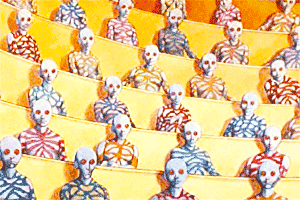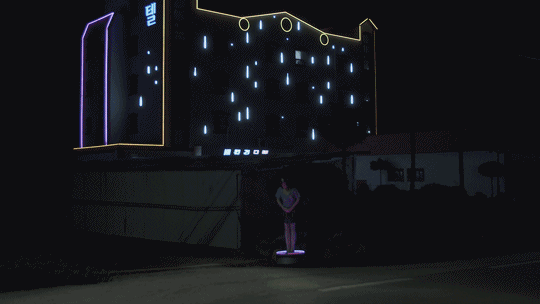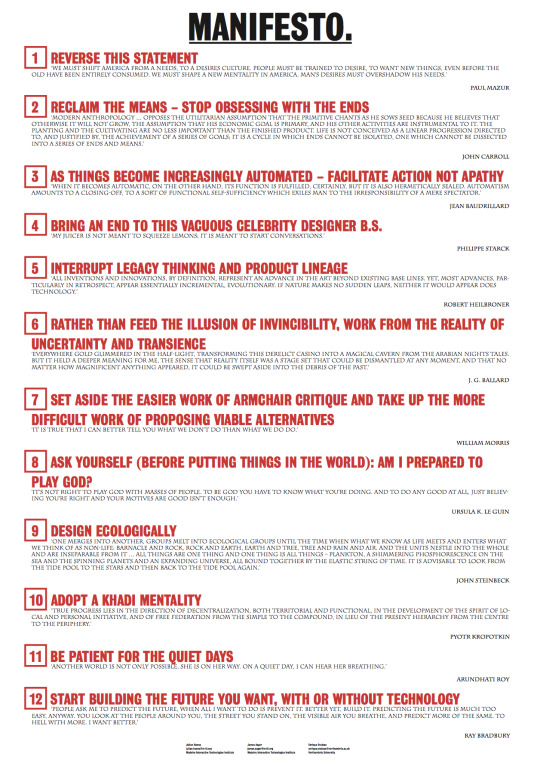Text
Plastic furniture exploding with age
*New forms of construction mean new means of decay.
https://www.nytimes.com/2018/03/02/style/design-plastics-midcentury.html
(…)
Collectors and scientists have started investigating how to stave off further damage and extend the life spans of endangered pieces designed by important innovators. In some cases, it turns out, the best solution is to maintain serenity and accept the materials’ innate fragility, inevitable decline and weird odors.
“Le plastique, it’s fantastique, but it’s toxique,” said Benoist F. Drut, the owner of Maison Gerard, a furniture gallery in Manhattan. He occasionally deals in objects that hardly anyone knows how to fix, including 1960s inflatable PVC armchairs that can lose their luster when exposed to the bodies of people wearing sunscreen and that can develop holes along their folds when deflated.
Adventurous mid-20th-century designers and manufacturers set out to test the limits of new plastics, and part of the fun was that no one knew how well the materials would age. The makers came up with unprecedented forms, too, just to see what would happen.
Why not, as the Italian designer Gaetano Pesce proposed in the 1960s, mold polyurethane foam lounge chairs into the shapes of the colossal marble feet on Michelangelo’s David?
Dr. Al Eiber, a retired physician in Miami, acquired a Pesce foot in the 1970s and mournfully threw away its ruined remains two decades later. He and his wife, Kim Kovel, came home from a short trip to find that its filling had inexplicably burst through its pinkish outer layer.
“It was like a nuclear explosion in our living room — foam had ripped through the skin,” Dr. Eiber said. The toes looked cancerous, and “the whole top of it, just boom!” He tried to donate its components to a museum for autopsy, he said, “but no one was interested.” He also owns a resin and Styrofoam bookcase by Mr. Pesce, which bulged and warped as gases formed in its depths. He drilled a hole to release the pressure, and since then the shelves have supported books well. “Except for that slight irregularity, it’s been great,” Dr. Eiber said….
1 note
·
View note
Photo










Fantastic Planet // La Planète sauvage (René Laloux - 1973)
6K notes
·
View notes
Text
Toronto: Google Smart City, or sump of technocratic oppression?
*Why not both?
https://www.cigionline.org/articles/searching-smart-citys-democratic-future
(…)
As a whole, the grand marketing vision for Toronto’s neighbourhood of the future is expansive and data driven, and speaks to issues of affordability, resilience and sustainability. It features underground garbage robots, autonomous vehicles, snow-melting sidewalks and more. While many of the features rely on the use of new technology and data to create responsive and adaptive places and spaces, other key features — modular housing and wooden buildings, for example — do not rely on new technology at all. The proposal also makes persistent mention of the need for access to more than the initial 12-acre plot of land for the innovations to be realized at scale. This nods to a possible play for a larger stake in the development of Toronto’s prime waterfront real estate.
Setting the particulars of this deal aside, there is definitely a case to be made for rethinking cities. Ken Greenberg, planner, author and adviser to Sidewalk Labs, puts it this way: “Our systems are strained; established ways of doing basic things are stretched to the limit and beyond…The Sidewalk partnership may just provide the catalyst, R&D resources, and the time and space we urgently need to help us make the leap in critical areas.”
While Greenberg’s definition of the problem is correct, the solution that’s on the table for Toronto should be considered somewhere on the spectrum of highly contentious to full-fledged democratic emergency. This piece will outline a series of approaches to address the challenges associated with Sidewalk Toronto’s vision for Quayside — or with any other smart city.
Commit to Open Procurement and Contracting
In February, The New York Times editorial board wrote that “we find ourselves at a moment of profound uncertainty about the role of technology in our lives, the influence of the tech companies and the correct direction of public policy to address all this change. We’re effectively asking technologists and policymakers to do so much — to secure our elections, to reinvent our business models, to educate and entertain and safeguard ourselves and our children, to protect us from extremists around the world. We expect all of this, across 200-plus nations and uncountable cultures, while also aspiring to privacy, transparency and prosperity.”
As the public becomes more aware about the impact of technology, they also grow more alert to related dangers that privacy and surveillance experts have been ringing alarms about for decades. This recent awakening should give cities permission to take decisions around smart cities seriously and slowly, and to demand open information about them. Procurement is a good place to start.
In Toronto, the opposite has played out. For nine months the public was kept in the dark about details of the deal, despite promises of an open and collaborative process and public pressure. Recently, however, both agreements that the organizations have signed were released. The newest agreement details the nature of the working arrangement between both organizations and some high-level language around data use. Still, the agreements are short on specifics, and they fail to impose baseline requirements around control of public data and publicly owned digital infrastructure…. (((etc etc)))
1 note
·
View note
Photo

Humans Not Invited
Project from Do Something Good is an online CAPTHCA which claims that only machines can pass. There is an ongoing debate on the Programming subreddit trying to decipher how it works.
a CAPTCHA (Completely Automated Public Turing test to tell Computers and Humans Apart) that filters out humans and only lets programs pass
Link
627 notes
·
View notes
Photo
One thing I keep rediscovering is how much I like work by Aleksandr Rodchenko.

9K notes
·
View notes
Photo




RGB Forest
Video from Oscar López Rocha continues his style of visual geometric jazz performed on footage, this time in a natural setting:
vimeo
When Red, Green and Blue come out to play…!!!
Music by BLÆRG
The song “Serotonin Diode (Lorocrom edit)” is a derivative of “Serotonin Diode” from album bottleimpproductions.bandcamp.com/…/everything-was-… by blaerg.bandcamp.com used under cc by-nc-sa.
Link
594 notes
·
View notes
Audio
(Tim Richardson) I've been working on this over the last month in little patches of time. Paul and Jon (of The Big Cats in Austin, TX) were kind enough to send me (separately) some short tracks (Paul's drums and Jon's acoustic guitar) as seeds. These I tortured, then sent several times through the filters on my Arturia Microbrute. The bass line is something simple I made on the Microbrute and there are some synth shimmers made on analog synth emulator apps. Finally narrowing in on a mix I like, maybe.
0 notes
Photo





Plastic Girls
Short film by Nils Clauss explores the spaces that use female-form robotic mannequins around South Korea to attract business:
vimeo
With slow graceful movements and digitally generated messages, Plastic Girls make a conspicuous contribution to the sexualisation of public space in front of their owners premises.
PLASTIC GIRLS is the last film of a Korea related trilogy following BIKINI WORDS and LAST LETTERS:
vimeo.com/151000182
vimeo.com/195284427
Link
312 notes
·
View notes
Photo





Star Wars to The Simpsons, Pulp Fiction, South Park and Seinfeld
Experiment by Jason Salavon explores visual representation with neural networks, using Star Wars as the source and translated using The Simpsons, Pulp Fiction, Seinfeld and South Park as datasets:
youtube
Using in-house developed neural network architecture (xGAN), we take a source video and generate new sequences that map the input’s compositional & temporal qualities to a destination dataset (transform Star Wars to The Simpsons, for example).
Link
65 notes
·
View notes
Text
Reconstrained Design
For the record, here is the Vorticism-inspired manifesto poster we brought to the Designing Interactive Systems conference in Edinburgh.

Find the full paper here: http://dis2017.org/provocations-works-in-progress/
Higher res version: https://www.dropbox.com/s/mnmolehr0j1t3gt/MANIFESTO.pdf?dl=0
7 notes
·
View notes
Photo

In case you needed more evidence we’re living in a 1984/Minority Report/Matrix dystopia and didn’t really notice.
53 notes
·
View notes
Video
youtube
Project Magenta: Music and Art with Machine Learning (Google I/O ‘17)
Presentation from Google I/O discusses a project to explore creativity through machine learning. The first half of the talk explores the visual side, looking at drawing analysis and exploring predictive drawing. The second half looks at audio and the possibilities of mixing new sounds.
Google Brain researcher Douglas Eck will discuss Magenta, a project using TensorFlow to generate art and music with deep nets and reinforcement learning. He’ll also talk about how artists and musicians fit in to the effort. We’ll dive into some of the technical details and challenges faced in building generative models, but no machine learning expertise is required to follow the session.
More about Magenta here
59 notes
·
View notes



